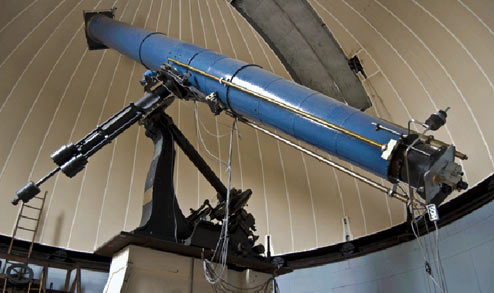Frank Leavenworth’s discoveries of NGC 1189, NGC 1190, NGC 1191, and NGC 1192 were some of the first using the 26-inch Alvan Clark refractor at the University of Virginia.
The question arises: Why did William and John Herschel miss these galaxies when discovering and observing NGC 1199 nearby? William Herschel used his favorite 18” reflector for the majority of his observations, although he had a 48” reflector available to him. The 18” telescope was easier to use. The Herschel’s larger 48” telescope had a copper mirror that was prone to tarnish and was very cumbersome to use. The 48” was little used and eventually abandoned , and its remains are part of a garden on his old estate. Hence, the advantage of a smaller telescope that is easy to use has led to the old amateur adage “the telescope that get used the most sees the most.” Frank Leavenworth, using the 26” Alvan Clark & Sons refracting telescope at the Leander McCormick Observatory at the University of Virginia in Charlottesville, Virginia had a significant aperture advantage over the 18” reflector used most often by the legendary William and John Herschel. The additional aperture and greater contrast of the Clark refractor enabled Leavenworth to observe and identify these additional galaxies.
The Leander McCormick Observatory was constructed using a gift by Mr. McCormick to build one of the largest telescopes in the world. The observatory was completed and dedicated on Thomas Jefferson’s birthday, on April 13, 1885. At the time, the 26-inch refractor was the second largest telescope in the world, tied for that rank with its sister 26-inch Alvan Clark refractor located nearby at the U.S. Naval Observatory in Washington D.C.
The 26 inch Alvan Clark refractor at the University of Virginia, the instrument could have been completed thirteen years earlier. Delays to its completion were caused by some financial difficulties that Leander McCrmick had at the time. By the time these funding issues were resolved, the Clarks had learned of some minor optical issues with the U.S. Naval Observatory instrument. The Naval Observatory 26 inch had an “object glass ghost” problem. Alvan Clark ground the inner surfaces of the University of Virginia objective to slightly different radii to avoid this minor optical issue. So, although the glass blanks for both telescopes were acquired at the same time, the two telescopes are slightly different in manufacture.

The Leander McCormick Observatory was constructed using a gift by Mr. McCormick to build one of the largest telescopes in the world. The observatory was completed and dedicated on Thomas Jefferson’s birthday, on April 13, 1885. At the time, the 26-inch refractor was the second largest telescope in the world, tied for that rank with its sister 26-inch Alvan Clark refractor located nearby at the U.S. Naval Observatory in Washington D.C.
The 26 inch Alvan Clark refractor at the University of Virginia, the instrument could have been completed thirteen years earlier. Delays to its completion were caused by some financial difficulties that Leander McCormick had at the time. By the time these funding issues were resolved, the Clarks had learned of some minor optical issues with the U.S. Naval Observatory instrument. The Naval Observatory 26 inch had an “object glass ghost” problem. Alvan Clark ground the inner surfaces of the University of Virginia objective to slightly different radii to avoid this minor optical issue. So, although the glass blanks for both telescopes were acquired at the same time, the two telescopes are slightly different in manufacture.